Linux进程控制&&进程等待&&程序替换&&实现minishell
一、进程创建
1.1 fork的使用
我们可以使用man指令来查看一下
man 2 fork
子进程会复制父进程的PCB,之间代码共享,数据独有,拥有各自的进程虚拟地址空间。

这里就有一个代码共享,并且子进程是拷贝了父进程的PCB,虽然他们各自拥有自己的进程虚拟地址空间,数据是拷贝过来的,通过页表映射到同一块物理内存中。
大概流程可以看一下下图:

在上图中我们还可以看到返回类型是pid_t,如果创建子进程失败,会返回小于0的数字,而如果创建子进程成功,该函数则会返回俩个值。它会给子进程返回0值,而给父进程返回子进程的pid(一个大于0的数),创建成功后我们可以对此进行使用if语句进行分流
下面简单验证再来验证一下:
#include <stdio.h>
#include <stdlib.h>
#include <unistd.h>
int g_val = 100;
int main()
{
pid_t pid = fork();
if(pid < 0) {
printf("fork error!\n");
exit(-1);
}
else if(pid == 0) {
//child
g_val = 200;
printf("This is Child! g_val = %d, p = %p\n",g_val,&g_val);
}
else {
//parent
sleep(1);
printf("This is Parent! g_val = %d, p = %p\n",g_val,&g_val);
}
return 0;
}
很显而易见,这里的地址是虚拟的地址空间,真正的值是存储在物理内存中的。而这时通过页表的映射,本质上内存中已经是指向了不同的物理地址

二、进程终止
2.1 终止是在做什么?
释放内核数据结构—>task_struct:Z(僵尸状态)
2.2 终止的3种情况&&退出码的理解
- 代码运行完毕,结果正确
- 代码运行完毕,结果不正确
- 代码异常终止
在上面的1和2中可通过退出码进行决定,这里什么是退出码呢?我们在C语言每次写的时候为什么最后写一个return 0呢?这里我们可以实验一下:
#include <stdio.h>
int main()
{
return 1;
}
这里我们还要了解一个命令
echo $?
作用是打印出上一次进程的退出码,而我们C语言刚刚最后写的退出码是1,最后记录了刚刚的退出码,所以打印的是1

- 第三个是代码执行的时候出现了异常,被提前退出了,我们可以再来验证一下:
- 下面这个代码很明显是野指针的访问:
int main()
{
int* p = NULL;
*p = 10;
return 0;
}

- 在编译运行的时候,出现了异常,提前退出了,操作系统发现了不该做的事情,OS杀死了进程
- 一旦出现了异常,退出码也就没有意义了,那么为什么出现了异常,是因为进程收到了OS发给进程的信号
在Linux中,可以使用kill -l查看所表示的信号,可以看到0表示成功~,所以一般正常运行完成之后退出码就写成0,非0表示失败
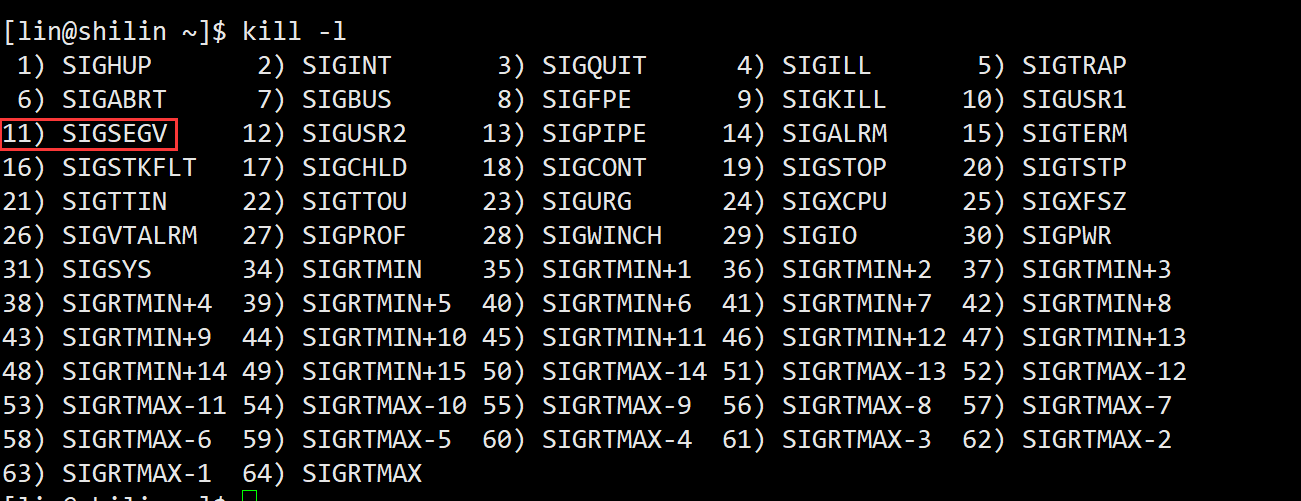
退出码(退出状态)可以告诉我们最后一次执行的命令的状态。在命令结束以后,我们可以知道命令是成功完成的还是以错误结束的。其基本思想是,程序返回退出代码 0 时表示执行成功,没有问题。代码1或0以外的任何代码都被视为不成功。
Linux Shell 中的主要退出码:
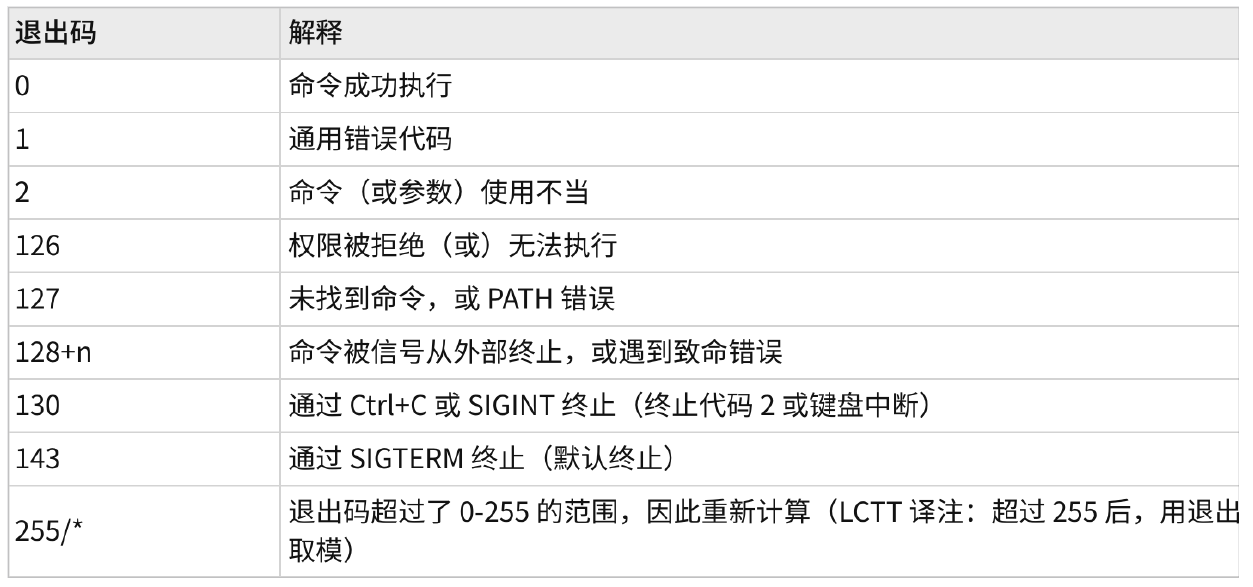
- 退出码 0 表示命令执行无误,这是完成命令的理想状态。
- 退出码 1 我们也可以将其解释为 “不被允许的操作”。例如在没有 sudo 权限的情况下使用yum;再例如除以 0 等操作也会返回错误码 1 ,对应的命令为
let a=1/0 130(SIGINT或^C)和143(SIGTERM)等终止信号是非常典型的,它们属于128+n信号,其中 n 代表终止码。- 可以使用strerror函数来获取退出码对应的描述。
2.3 进程常见退出方法
- 正常退出
- 从main函数返回
- 调用exit函数
- 调用_exit函数
- 异常退出
- Ctrl+C,信号终止等
在我们平时使用的kill -9就是给OS发送一个信号,对程序做出动作

- 例如,使用-9信号杀死进程

- 刚刚上面的段错误就可以发送11
- 每个对应的编号都有对应的错误描述

exit退出函数和_exit退出函数:
可以使用man手册来查看
stauts定义了进程的终止状态,由用户自己传递,父进程可以通过wait来获取该值
说明:虽然status是int,但是仅有
低8位可以被父进程所用。所以_exit(-1)时,在终端执行$?发现返回值是255。
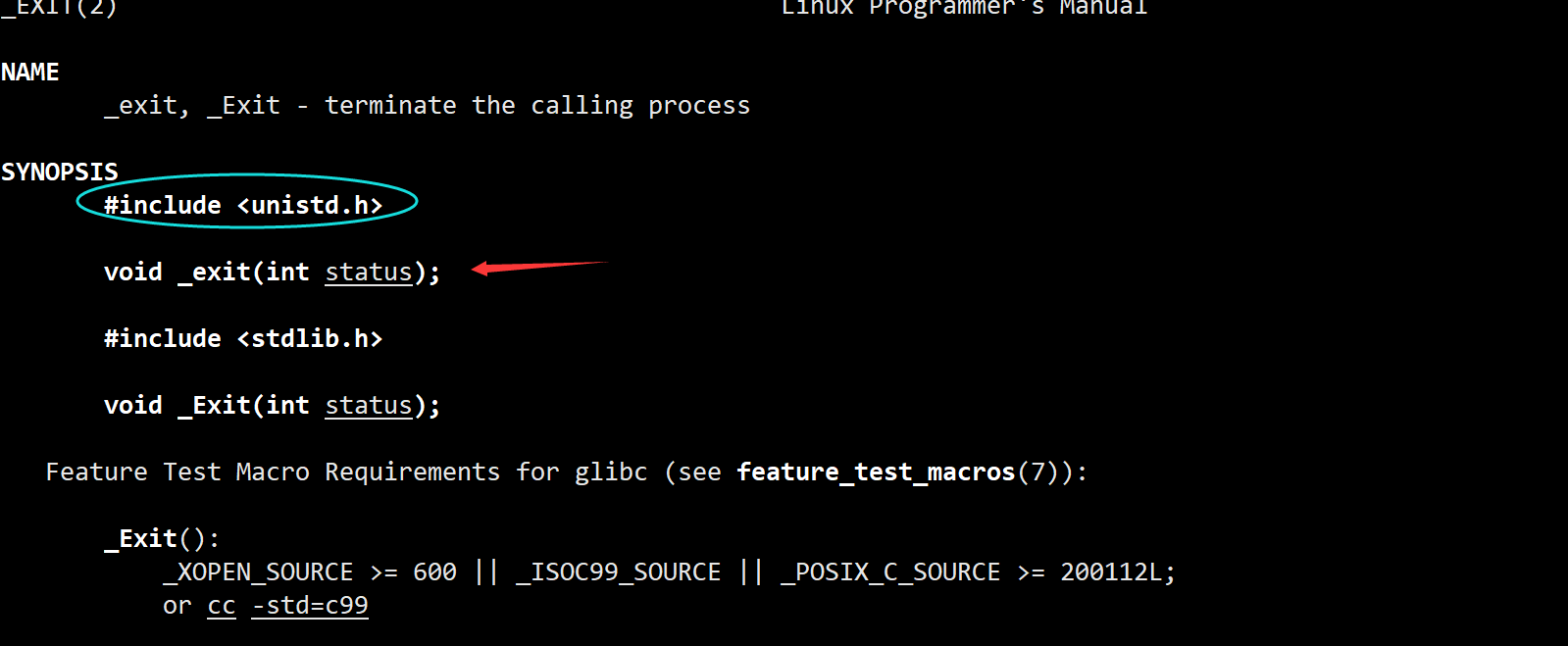
- exit是库函数,_exit是系统调用函数,而库函数内部封装了系统调用。 也就是说,调用exit函数最终也会调用_exit来使进程退出,只不过在其调用_exit之前,还做了其他工作:
- 执行用户通过 atexit或on_exit定义的清理函数。
- 关闭所有打开的流,所有的缓存数据均被写入
- 调用_exit
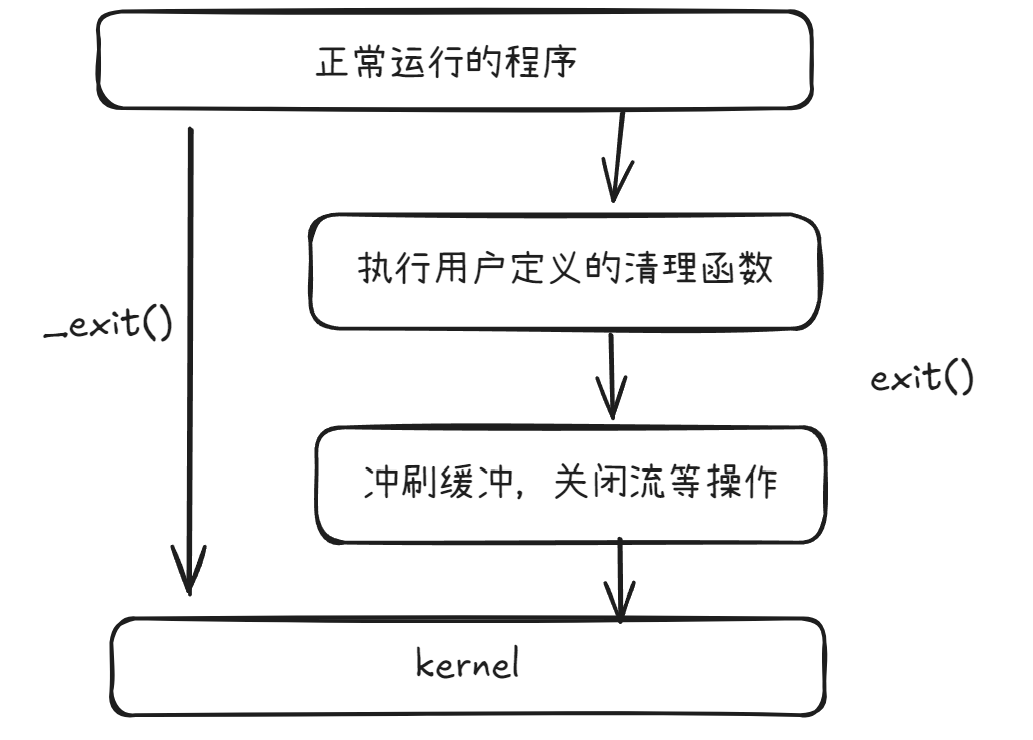
return退出
- return是一种更常见的退出进程方法。执行
return n等同于执行exit(n),因为调用main的运行时函数会将main的返 回值当做exit的参数。
也就是说衡量一个进程退出,我们只需要两个数字:退出码和退出信号
三、进程等待
3.1 为什么要进行进程等待?
如果子进程先于父进程退出,而父进程并没有关心子进程的退出状况,从而无法回收子进程的资源,就会导致子进程变成僵尸进程,这里的僵尸状态使用kill也杀不掉,会导致内存泄露
如果想要解决这个僵尸状态就要进行进程等待,等待父进程回收子进程的资源,获取子进程的退出状态
在父进程中,使用wait或waitpid接口来完成进程等待。
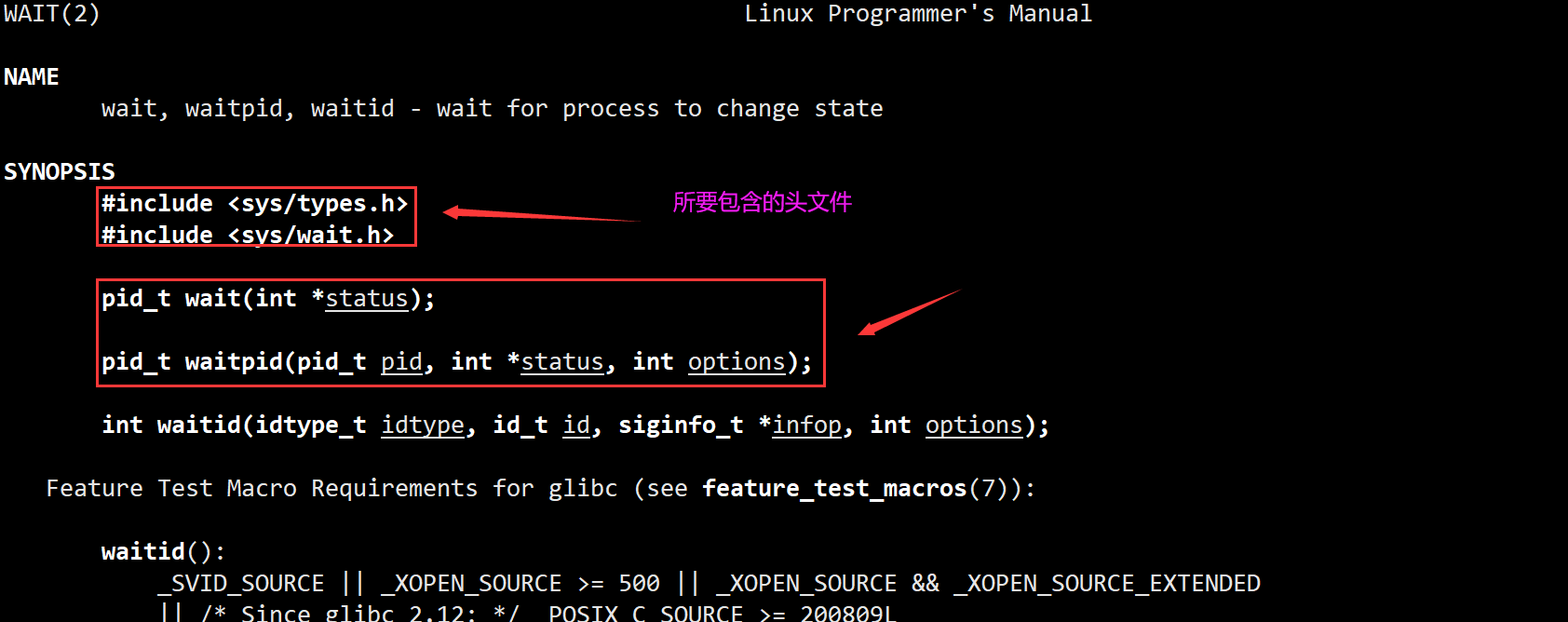
这里的参数是一级指针status,它其实是个输出型参数,用于获取子进程的退出状态,如果不关心则可以设置为NULL
成功会返回被等待进程的pid,失败则会返回-1
#include <stdio.h>
#include <unistd.h>
#include <stdlib.h>
#include <string.h>
#include <sys/types.h>
#include <sys/wait.h>
int main()
{
pid_t id=fork();
if(id==0)
{
// child process
int cnt=10;
while(cnt)
{
printf("我是子进程:%d,父进程:%d,cnt:%d\n",getpid(),getppid(),cnt--);
sleep(1);
}
exit(0);// 子进程退出
}
sleep(15);
pid_t ret=wait(NULL);
if(ret>0)
{
printf("wait success:%d!\n",ret);
}
sleep(5);
return 0;
}
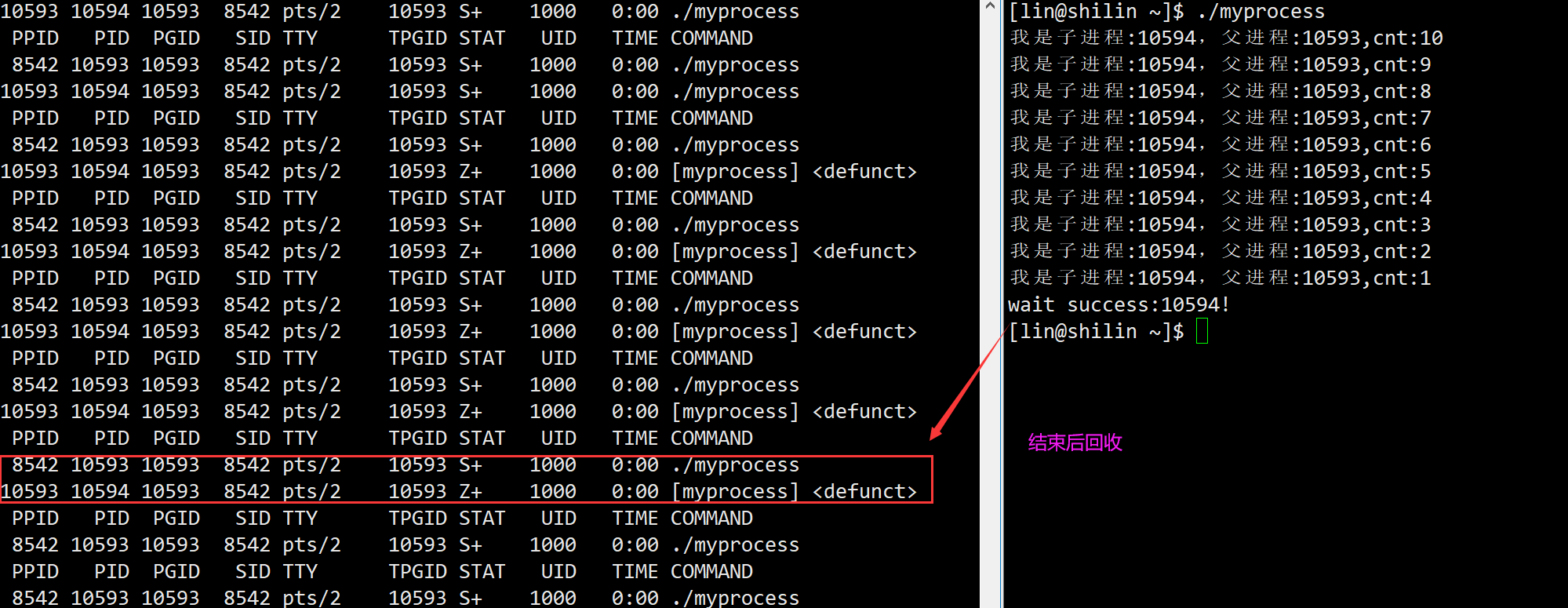
waitpid:
参数:
- pid,设置成-1则表示等待任意一个子进程,同wait;如果>0则表示等待一个指定的子进程,pid就是被等待子进程的进程号
- status,获取子进程的退出状态,同wait
- options,可以设置为0或WNOHANG。设置为0则与wait一样,如果没有等待到子进程退出会一直阻塞;而设置为
WNOHANG则表示非阻塞,如果被等待的子进程未退出,则会返回0值,成功等待到子进程则会返回被等待子进程的pid
3.2 取子进程退出信息status
- 我们已经知道status是一个出参,由操作系统为其赋值,用户可以传递NULL值表示不关心,而如果传入参数,操作系统就会根据该参数,将子进程的退出信息反馈给父进程,由status最终被赋予的值来体现。
如何通过status来获取子进程的退出信息呢?
- status是一个int类型的值,意味着它应该有32个比特位,但它又不能被当初普通的整形来看待,因为其高16位的值并不被使用,而**只使用其低16个比特位**:

不论是正常退出还是异常退出,status的高8个比特位(只讨论低16个比特位)都表示子进程的退出码,而这个退出码一般是return的返回值或者exit的参数;正常退出时,status的低8个比特位为全0;而异常退出时,其第8个比特位则为core dump标志位,用来标志是否会有core dump文件产生,而低7个比特位则是退出信号。
退出码:(status >> 8) & 0xFF
低7位(检测子进程是否异常退出):status & 0x7F
- 结果为0则表示正常退出
- 不为0则说明是异常退出,因为有终止信号
- core dump标志位:
(status >> 7) & 0x1 - 结果为0则表示没有core dump产生
- 等于1则说明有core dump产生
#include <unistd.h>
#include <stdlib.h>
#include <string.h>
#include <sys/types.h>
#include <sys/wait.h>
int main()
{
pid_t id=fork();
if(id==0)
{
// child process
int cnt=10;
while(cnt)
{
printf("我是子进程:%d,父进程:%d,cnt:%d\n",getpid(),getppid(),cnt--);
sleep(1);
}
exit(6);// 子进程退出,故意写退出码为6
}
sleep(15);
int status = 0;
pid_t ret=waitpid(id,&status,0);
if(ret>0)
{
printf("wait success:%d!\n",ret);
printf("status:%d,退出码是%d,退出信号是%d\n",status,(status>>8)&0xFF,status&0x7F);
}
sleep(5);
return 0;
}

- 执行结果

我们还可以演示一下异常退出
- 我们在子进程里写一个野指针访问
int* p = NULL;
*p = 100;
- 这里也就很显而易见了,退出信号就是11,而退出码就无用了

3.3 宏WIFEXITED和WEXITSTATUS(获取进程终止情况和退出码)
- WIFEXITED(status):若子进程是正常终止,则返回结果为真,用于查看进程是否正常退出。
- WEXITSTATUS(status):若进程正常终止,也就是进程终止信号为0,这时候会返回子进程的退出码。
下面我们可以写一个代码来演示一下
#include <stdio.h>
#include <sys/types.h>
#include <sys/wait.h>
#include <unistd.h>
#include <stdlib.h>
#include <assert.h>
int main()
{
pid_t id = fork();
assert(id != -1);
if(id == 0)
{
// child
int cnt = 10;
while(cnt)
{
printf("child process running,pid:%d,ppid:%d,cnt:%d\n",getpid(),getppid(),cnt--);
sleep(1);
}
exit(10); // 故意写退出码为10
}
// 等待子进程
int status=0;
int ret = waitpid(id,&status,0);
if(ret > 0)
{
if(WIFEXITED(status)) // 如果正常退出返回结果为真,然后查看退出码
printf("child process exit normally,exit code:%d\n",WEXITSTATUS(status));
else
printf("child process don't exit normally\n");
}
return 0;
}
- 正常退出

- 异常退出

3.4 进程的阻塞和非阻塞等待
当子进程还没有死的时候,也就是没有退出的时候,父进程调用的wait或waitpit需要等待子进程退出,系统调用接口也不返回,这段时间父进程什么都没做,就一直等待子进程退出,这样的等待方式,称之为阻塞式等待。
非阻塞式等待就是不停的检测子进程状态,每一次检测之后,系统调用立即返回,在waitpid中的第三个参数设置为WNOHANG,即为父进程非阻塞式等待。
如果等待的子进程状态没有发生变化,则waitpid会返回0值。多次非阻塞等待子进程,直到子进程退出,这样的等待方式又称之为轮询。如果等待的进程不是当前父进程的子进程,则waitpid会调用失败。
#include <stdio.h>
#include <sys/types.h>
#include <sys/wait.h>
#include <unistd.h>
#include <stdlib.h>
#include <assert.h>
int main()
{
pid_t id = fork();
assert(id!=-1);
if(id==0)
{
// child process
int cnt=5;
while(cnt)
{
printf("child process running,pid:%d,ppid:%d,cnt:%d\n",getpid(),getppid(),cnt--);
sleep(3);
}
exit(10);
}
int status=0;
while(1)
{
// WNOHANG是非阻塞等待,子进程没有退出,父进程检测一次之后,立即返回
pid_t ret=waitpid(id,&status,WNOHANG);
if(ret == 0)
{
// waitpid调用成功,子进程没有退出
printf("Wait for success,but the child process is still running\n");
}
else if(ret == id)
{
// waitpid调用成功,子进程退出
printf("wait success,exit code:%d,signal number:%d\n",(status >> 8) & 0xFF, status & 0x7F);
break;
}
else
{
// waitpid调用失败,例如等待了一个不属于该父进程的子进程
printf("The waitpid call failed\n");
break;
}
sleep(1);
}
return 0;
}

非阻塞等待有一个好处就是,不会像阻塞式等待一样,父进程什么都做不了,而是在轮询期间,父进程还可以做其他的事情。
下面代码中,利用了回调函数的方式,来让父进程轮询等待子进程期间,还可以处理其他任务。
#include <stdio.h>
#include <sys/types.h>
#include <sys/wait.h>
#include <unistd.h>
#include <stdlib.h>
#include <assert.h>
#include <string.h>
void task1()
{
printf("Process task1\n");
}
void task2()
{
printf("Process task2\n");
}
void task3()
{
printf("Process task3\n");
}
typedef void (*func_t)(); // 定义一个函数指针类型
func_t Process_task[10];
void loadtask()
{
memset(Process_task,0, sizeof(Process_task));
Process_task[0]=task1;
Process_task[1]=task2;
Process_task[2]=task3;
}
int main()
{
pid_t id = fork();
assert(id!=-1);
if(id==0)
{
// child process
int cnt=5;
while(cnt)
{
printf("child process running,pid:%d,ppid:%d,cnt:%d\n",getpid(),getppid(),cnt--);
sleep(1);
}
exit(10);
}
loadtask();// 加载任务到函数指针数组里面
int status=0;
while(1)
{
pid_t ret=waitpid(id,&status,WNOHANG);// WNOHANG是非阻塞等待,子进程没有退出,父进程检测一次之后,立即返回
if(ret == 0)
{
// waitpid调用成功,子进程没有退出
printf("Wait for success,but the child process is still running\n");
for(int i=0; Process_task[i]!=NULL; i++)
{
Process_task[i]();// 回调函数的方式,让父进程在轮询期间,做其他事情
}
}
else if(ret == id)
{
// waitpid调用成功,子进程退出
printf("wait success,exit code:%d,signal number:%d\n",(status>>8)&0xFF,status & 0x7F);
break;
}
else
{
// waitpid调用失败,例如等待了一个不属于该父进程的子进程
printf("The waitpid call failed\n");
break;
}
sleep(1);
}
return 0;
}

或者可以使用C和C++混编的方来写
- 创建任务
Task.hpp
#pragma once
#include <iostream>
void DownLoad()
{
std::cout << "我是一个下载任务" <<std::endl;
}
void PrintLog()
{
std::cout << "我是一个打印日志的任务" << std::endl;
}
void FlushData()
{
std::cout << "我是一个刷新数据的任务" << std::endl;
}
Tool.hpp
#pragma once
#include <iostream>
#include <vector>
#include <functional>
using func_t = std::function<void()>;
class Tool
{
public:
void pushFunc(func_t f)
{
_funcs.push_back(f);
}
void Execute()
{
for(auto& f : _funcs)
{
f();
}
}
private:
std::vector<func_t> _funcs;
};
- 代码实现:父进程循环执行任务
#include <stdio.h>
#include <string.h>
#include <unistd.h>
#include <stdlib.h>
#include <sys/types.h>
#include <sys/wait.h>
#include <iostream>
#include <assert.h>
#include "Task.hpp"
#include "Tool.hpp"
int main()
{
Tool tool;
tool.pushFunc(DownLoad);
tool.pushFunc(PrintLog);
tool.pushFunc(FlushData);
pid_t id = fork();
assert(id!=-1);
if(id==0)
{
// child process
int cnt=5;
while(cnt)
{
printf("child process running,pid:%d,ppid:%d,cnt:%d\n",getpid(),getppid(),cnt--);
sleep(1);
}
exit(10);
}
int status = 0;
while(1)
{
// WNOHANG是非阻塞等待,子进程没有退出,父进程检测一次之后,立即返回
pid_t ret=waitpid(id,&status,WNOHANG);
if(ret == 0)
{
// waitpid调用成功,子进程没有退出
printf("Wait for success,but the child process is still running\n");
// 父进程做其他事情
tool.Execute();
sleep(1);
}
else if(ret == id)
{
// waitpid调用成功,子进程退出
printf("wait success,exit code:%d,signal number:%d\n",(status >> 8) & 0xFF, status & 0x7F);
break;
}
else
{
// waitpid调用失败,例如等待了一个不属于该父进程的子进程
printf("The waitpid call failed\n");
break;
}
sleep(1);
}
return 0;
}
waitpid本质是获取子进程task_struct内的属性数据,和getpid没区别,它调用完毕的时候,也会让os释放目标task_struct
每个task_struct里有exit_code, exit_signal,是要保存下来退出码和退出状态

这就是为什么子进程退出,Z状态,不能释放task_struct,要让父进程进行读取
四、进程的程序替换
4.1 创建子进程的目的?
创建子进程一般两个目的:
- 让子进程执行父进程代码的一部分,也就是执行父进程对应的磁盘上的代码和数据的一部分。
- 让子进程加载磁盘上指定的程序到内存中,使其执行新的程序的代码和数据,这就是进程的程序替换。
4.2 进程的程序替换
4.2.1 单个进程的程序替换
下面函数参数是可变参数列表,可以给C语言函数传递不同个数的参数。
int execl(const char* path,const char* arg,...);
通过man指令可以查看
man execl
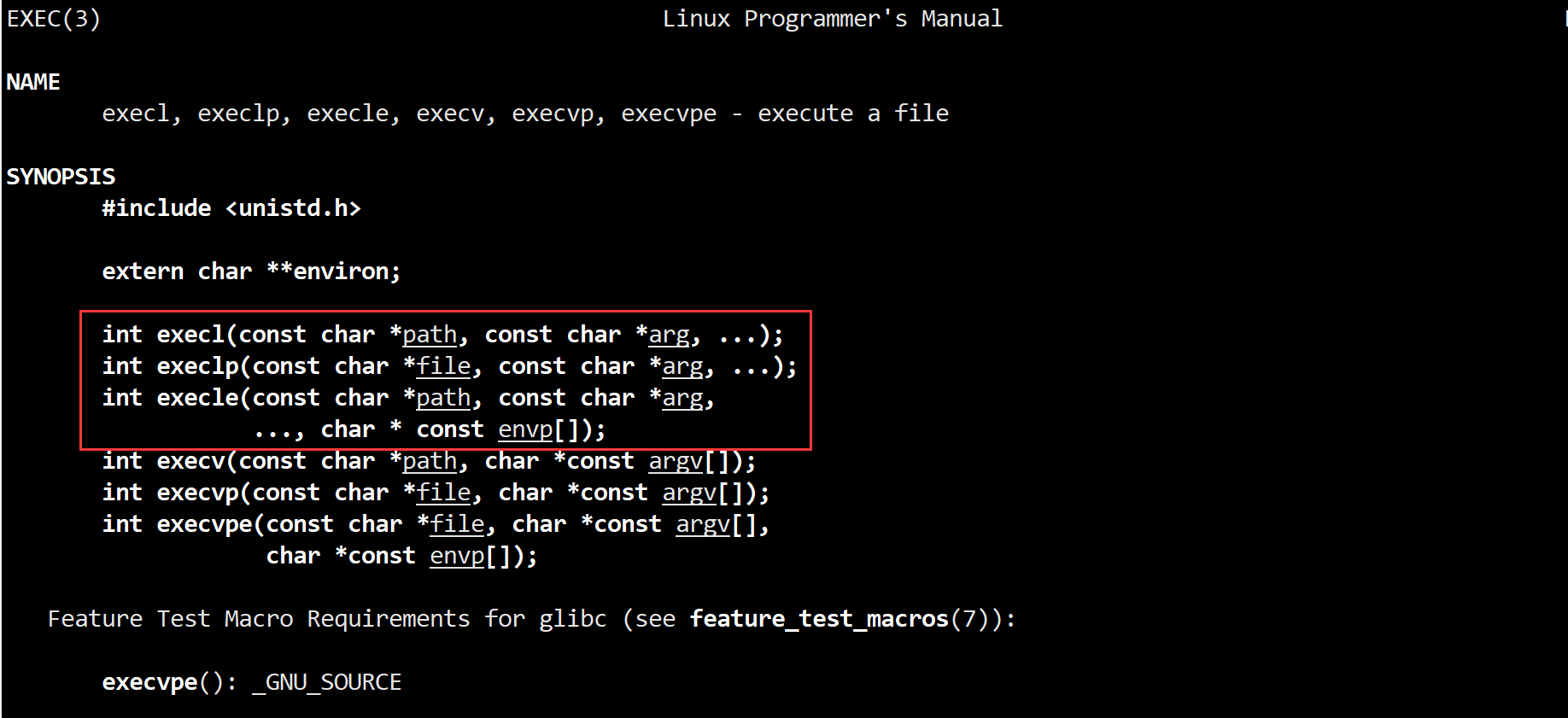
要执行一个程序,首先就是找到这个程序,然后在执行这个程序,执行程序的时候,也拥有不同的执行方式,通过执行选项的不同便可以使得程序以多种不同的方式执行。
例如:
#include <stdio.h>
#include <unistd.h>
int main()
{
// .c --> .exe --> load into memory --> process --> running
printf("The process is running...\n");
// 传参以NULL结尾,来表示传参结束
execl("/usr/bin/ls","ls","-a","-l","--color=auto",NULL);
printf("The process finishes running...\n");
return 0;
}
- 可以看到只打印了一行run,紧接着是执行后面替换的程序

- exec系列的函数只有在调用失败的时候才有返回值,这个返回值是-1,那为什么exec系列的函数没有调用成功时的返回值呢?
答案:没有必要,因为exec系列函数调用结束之后,代码就全都被替换了,就算给你返回值你也使用不了,因为代码全都替换为指定程序的代码了,所以只要exec系列函数返回,那就一定发生调用错误了。
例如:随便写一个命令,这个命令是不在这个目录里的
#include <stdio.h>
#include <unistd.h>
int main()
{
// .c --> .exe --> load into memory --> process --> running
printf("The process is running...\n");
// 传参以NULL结尾,来表示传参结束
execl("/usr/bin/lsss","ls","-l","--color=auto",NULL);
printf("The process finishes running...\n");
return 0;
}

4.2.2 父进程派生子进程的程序替换
子进程被替换为ls进程,不会影响父进程,因为进程具有独立性。
#include <stdio.h>
#include <unistd.h>
#include <stdlib.h>
#include <assert.h>
#include <sys/types.h>
#include <sys/wait.h>
int main()
{
printf("The process is running...\n");
pid_t id = fork();
assert(id != -1);
if(id==0)
{
//child process
sleep(1);
execl("/usr/bin/ls","ls","-l",NULL);
exit(1);// 如果调用失败,直接让子进程退出
}
int status = 0;
pid_t ret = waitpid(id,&status,0);
if(ret == id)
{
printf("wait success, exit code:%d , signal number:%d\n",(status>>8)&0xFF,status&0x7F);
}
return 0;
}

4.3 进程替换原理
用fork创建子进程后执行的是和父进程相同的程序(但有可能执行不同的代码分支),子进程往往要调用一种exec函数以执行另一个程序。当进程调用一种exec函数时,该进程的用户空间代码和数据完全被新程序替换,从新程序的启动例程开始执行。调用exec并不创建新进程所以调用exec前后该进程的id并未改变。

当父进程派生的子进程发生程序替换时,防止父子进程原先共享的代码段和数据段被修改,操作系统会进行写时拷贝,将代码段和数据段重新复制一份给子进程,让子进程程序替换之后,不会影响父进程。这就是进程之间的独立性。
虚拟地址空间和页表可以保证进程之间的独立性,一旦有执行流要改变代码或数据,就会发生写时拷贝。所以不是只有数据可能发生写入,代码也是有可能发生写入的,这两种情况都会发生写时拷贝。
通过上面认识知道:在我们用命令行使用ls之类的命令,父进程bashfork出一个子进程,然后调用exec*,父进程wait就可以了!
五、替换函数
#include <unistd.h>
int execl(const char *path, const char *arg, ...);
int execlp(const char *file, const char *arg, ...);
int execle(const char *path, const char *arg, ..., char * const envp[]);
int execv(const char *path, char *const argv[]);
int execvp(const char *file, char *const argv[]);
int execvpe(const char *file, char *const argv[], char *const envp[]);
- l代表list,指的是将参数一个一个的传入
execl函数
int execl(const char *path, const char *arg, …);
int main()
{
pid_t id = fork();
if(id == 0){
// child
execl("/usr/bin/ls", "ls", "-l", NULL);
// 如果执行到这里说明替换失败,让子进程退出
exit(-1);
}
// parent
return 0;
}
- p是指path,不用传程序的路径,只需要传程序的名字就够了,此函数会自动在PATH环境变量的路径下面去查找对应的程序。
- execlp中的两个ls是不重复的,一个是告诉操作系统要执行什么程序(无论是Python脚本,还是shell语言脚本等等都可以执行!!!),一个是告诉操作系统怎么执行程序。
int execlp(const char *file, const char *arg, …);
int main()
{
pid_t id = fork();
if(id == 0){
// child
execlp("ls", "ls", "-l", "--color=auto", NULL);
// 如果执行到这里说明替换失败,让子进程退出
exit(-1);
}
// parent
return 0;
}
- v是指vector,指的是该函数可以将所有的执行参数放到数组里面,统一进行传参,而不是使用可变参数列表的方式,来一个一个的传执行参数。
int execv(const char *path, char *const argv[]);
int main()
{
pid_t id = fork();
if(id == 0){
// child
char* const argv[] = {(char*)"ls", (char*)"-l", (char*)"--color=auto", NULL};
execv("/usr/bin/ls", argv);
// 如果执行到这里说明替换失败,让子进程退出
exit(-1);
}
// parent
return 0;
}
- PATH和vector,指的是不用传程序路径,默认在环境变量中进行查找并且可以将执行参数放到数组里面,统一进行传参
int execvp(const char *file, char *const argv[]);
int main()
{
pid_t id = fork();
if(id == 0){
// child
char* const argv[] = {(char*)"ls", (char*)"-l", (char*)"--color=auto", NULL};
execvp("ls", argv);
// 如果执行到这里说明替换失败,让子进程退出
exit(-1);
}
// parent
return 0;
}
- execle中的e代表自定义环境变量。
- 下面定义的env指针数组就是自定义环境变量,也就意味着,程序替换的时候,不用系统环境变量,用自己定义的环境变量。
int execle(const char *path, const char *arg,…, char * const envp[]);
int main()
{
pid_t id = fork();
if(id == 0){
// child
char* const env[] = {(char*)"HELLO=123456789",NULL};
execle("./mybin","mybin", NULL, env);
// 如果执行到这里说明替换失败,让子进程退出
exit(-1);
}
// parent
return 0;
}
- 也可以不传自定义环境变量,而用系统的环境变量传给子进程替换的程序,只不过替换的程序mybin.c没有打印出来全部的环境变量,而是只打印了PATH和PWD的值。
int main()
{
pid_t id = fork();
if(id == 0){
// child
extern char** environ;
execle("./mybin","mybin", NULL, environ);
// 如果执行到这里说明替换失败,让子进程退出
exit(-1);
}
// parent
return 0;
}
其实上面那些函数都不在2号手册
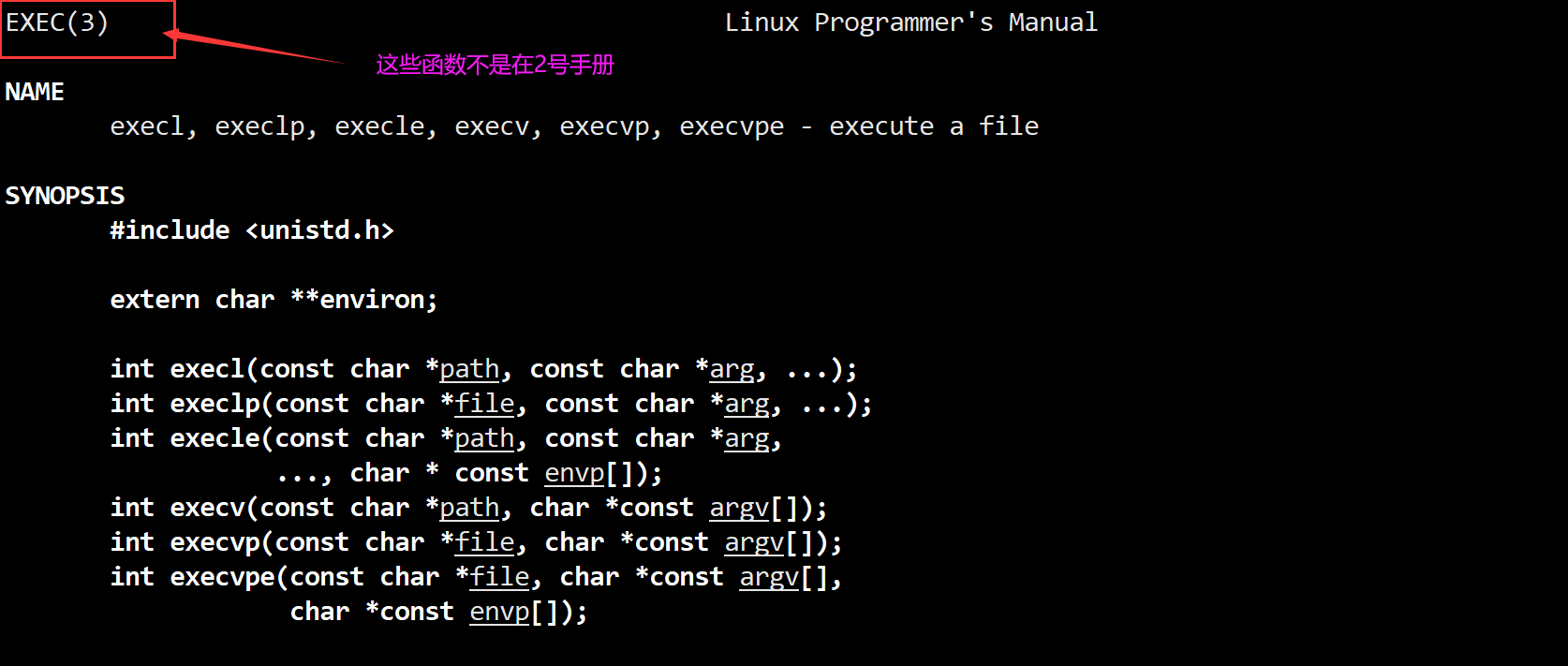
int execvpe(const char *file, char *const argv[],char *const envp[]);
- execvpe其实就是
vector+PATH+env,我们需要自己传环境变量,并且不用可变参数列表的方式传执行参数,而是用指针数组的方式来一并将执行参数传递,传程序名时可以不带程序路径,系统会帮我们找。 - 带e的函数都需要自己组装环境变量,可以选择自己的、或系统的、或系统和自己的环境变量。
- 传递环境变量表,默认是摒弃老的环境变量,使用你自己设置的全新的环境变量表。如果你要用系统提供的,你就传入系统的环境变量表

- 真正执行程序替换的其实只有execve这一个系统调用接口,其他的6个都是在execve的基础上封装得来的。只有execve在man2号手册,其他都在3号手册。

下图exec函数族,一个完整的例子:

- 其中
l和v的区别在于程序运行参数的赋予方式不同,l是通过函数参数逐个给与,最终以NULL结尾,而v是通过字符指针数组一次性给与。 - 其中有没有
**p**的区别在于程序是否需要带路径,也就是是否会默认到path环境变量指定的路径下寻找程序,没有p的需要指定路径,有p的会默认到path环境变量指定路径下寻找 - 其中有没有
**e**的区别在于程序是否需要自定义环境变量,没有e则默认使用父进程环境变量,有e则自定义环境变量。
最后在写makefile的时候我们想让两个源文件进行编译,我们可以在makefile中添加一个:
.PHONY:all
all:mybin myprocess
mybin:myexec.c
gcc -o $@ $^ -std=c99
myprocess:process.c
gcc -o $@ $^ -std=c99
.PHONY:clean
clean:
rm -rf myprocess mybin
exec函数族代码示例:
int main()
{
char *const argv[] = {"ps", "-ef", NULL};
char *const envp[] = {"PATH=/bin:/usr/bin", "TERM=console", NULL};
execl("/bin/ps", "ps", "-ef", NULL);
// 带p的,可以使用环境变量PATH,无需写全路径
execlp("ps", "ps", "-ef", NULL);
// 带e的,需要自己组装环境变量
execle("ps", "ps", "-ef", NULL, envp);
execv("/bin/ps", argv);
// 带p的,可以使用环境变量PATH,无需写全路径
execvp("ps", argv);
// 带e的,需要自己组装环境变量
execve("/bin/ps", argv, envp);
exit(0);
}
六、自己实现简易shell
要写一个shell,需要循环以下过程:
- 获取命令行
- 解析命令行
- 建立一个子进程(fork)
- 替换子进程(execvp)
- 父进程等待子进程退出(wait)
6.1 shell代码使用C实现
#include <stdio.h>
#include <stdlib.h>
#include <string.h>
#include <errno.h>
#include <unistd.h>
#include <sys/types.h>
#include <sys/wait.h>
#define SIZE 512
#define ZERO '\0'
#define SEP " "
#define NUM 32
#define SkipPath(p) do{ p += (strlen(p)-1); while(*p != '/') p--; }while(0)
char cwd[SIZE*2];
char *gArgv[NUM];
int lastcode = 0;
void Die()
{
exit(1);
}
const char *GetHome()
{
const char *home = getenv("HOME");
if(home == NULL) return "/";
return home;
}
const char *GetUserName()
{
const char *name = getenv("USER");
if(name == NULL) return "None";
return name;
}
const char *GetHostName()
{
const char *hostname = getenv("HOSTNAME");
if(hostname == NULL) return "None";
return hostname;
}
const char *GetCwd()
{
const char *cwd = getenv("PWD");
if(cwd == NULL) return "None";
return cwd;
}
void MakeCommandLineAndPrint()
{
char line[SIZE];
const char *username = GetUserName();
const char *hostname = GetHostName();
const char *cwd = GetCwd();
SkipPath(cwd);
snprintf(line, sizeof(line), "[%s@%s %s]> ", username, hostname, strlen(cwd) == 1 ? "/" : cwd+1);
printf("%s", line);
fflush(stdout);
}
int GetUserCommand(char command[], size_t n)
{
char *s = fgets(command, n, stdin);
if(s == NULL) return -1;
command[strlen(command)-1] = ZERO;
return strlen(command);
}
void SplitCommand(char command[], size_t n)
{
(void)n;
gArgv[0] = strtok(command, SEP);
int index = 1;
while((gArgv[index++] = strtok(NULL, SEP)));
}
void ExecuteCommand()
{
pid_t id = fork();
if(id < 0) Die();
else if(id == 0)
{
// child
execvp(gArgv[0], gArgv);
exit(errno);
}
else
{
// fahter
int status = 0;
pid_t rid = waitpid(id, &status, 0);
if(rid > 0)
{
lastcode = WEXITSTATUS(status);
if(lastcode != 0) printf("%s:%s:%d\n", gArgv[0], strerror(lastcode), lastcode);
}
}
}
void Cd()
{
const char *path = gArgv[1];
if(path == NULL) path = GetHome();
// path 一定存在
chdir(path);
// 刷新环境变量
char temp[SIZE * 2];
getcwd(temp, sizeof(temp));
snprintf(cwd, sizeof(cwd), "PWD=%s", temp);
putenv(cwd);
}
int CheckBuildin()
{
int yes = 0;
const char *enter_cmd = gArgv[0];
if(strcmp(enter_cmd, "cd") == 0)
{
yes = 1;
Cd();
}
else if(strcmp(enter_cmd, "echo") == 0 && strcmp(gArgv[1], "$?") == 0)
{
yes = 1;
printf("%d\n", lastcode);
lastcode = 0;
}
return yes;
}
int main()
{
int quit = 0;
while(!quit)
{
// 1. 我们需要自己输出一个命令行
MakeCommandLineAndPrint();
// 2. 获取用户命令字符串
char usercommand[SIZE];
int n = GetUserCommand(usercommand, sizeof(usercommand));
if(n <= 0) return 1;
// 3. 命令行字符串分割.
SplitCommand(usercommand, sizeof(usercommand));
// 4. 检测命令是否是内建命令
n = CheckBuildin();
if(n) continue;
// 5. 执行命令
ExecuteCommand();
}
return 0;
}
6.2 什么是当前路径?(当前进程的工作目录 && cd底层实现用chdir)
- 查看进程的指令:
ls /proc/进程id

- 可以看到进程有两个路径,一个是cwd一个是exe,exe路径代表当前进程执行的是磁盘上的哪个路径下的程序,可以看到执行的是myproc二进制可执行程序,cwd代表current work directory,代表当前进程的工作目录,所以实际上当前路径就是当前进程的工作目录。
- 在模拟shell的实现代码中,cd到其他目录,pwd之后的路径实际上是没有变化的,因为pwd实际上pwd的是父进程shell的路径,而父进程的cwd路径始终是未改变的,而执行cd命令的是子进程,所以子进程的cwd路径是会改变的。
- 系统给我们提供了一个系统调用接口叫做
chdir,用于改变当前进程的工作目录cwd路径,实际上cd能够进入指定路径下的目录,底层实现上就是改变了shell(bash)进程的cwd路径,所以pwd时,随时随地打印出来的就是shell进程的工作目录。 - 所以如果我们模拟实现的shell也想实现cd改变路径的功能,实际上是不可以创建子进程的,因为子进程程序替换执行cd,父进程的工作目录是没有改变的,所以直接将这一种情况单独拿出来进行判断,在这种情况下,直接让父进程执行cd命令,修改父进程的工作目录即可。
6.3 shell内建/内置命令(shell自己执行的命令,而不是派生子进程进行程序替换来执行)
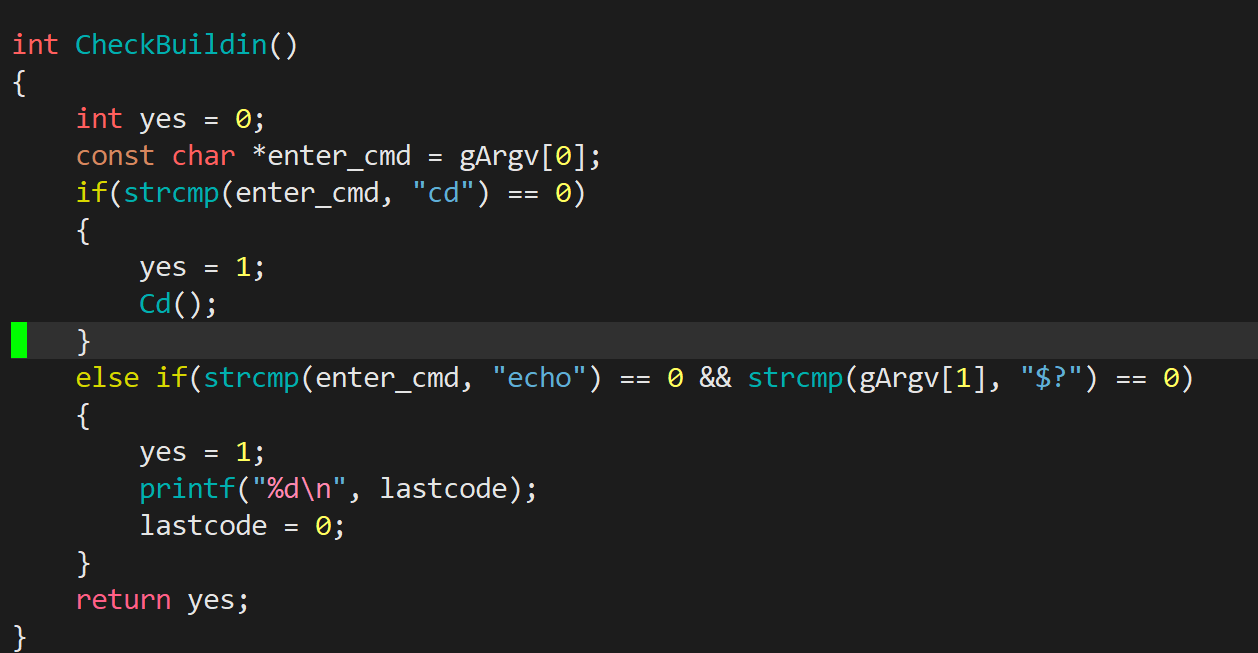
- 像上面的cd命令实际上就是shell的内建命令,因为这样的命令不需要派生子进程来进行程序替换执行,直接让父进程执行就ok,这样的指令就是shell自带的命令,我们称之为内建命令或内置命令。
- 这也就能解释为什么echo能够打印本地变量了,我们之前将echo理解为一个可执行程序,也就是shell的子进程,但是我们说子进程只能继承父进程的环境变量,而不能继承本地变量,所以当时就陷入echo为什么能够打印出本地变量的疑问当中,因为如果echo是子进程的话,他是没有继承本地变量的。
- 但现在我们就知道原因了,echo实际上不是shell的子进程,而是shell的内建命令,是shell自己来执行的指令,shell当然拥有本地变量了,当然也就能够打印本地变量。
6.4 shell代码使用C和C++混编实现
- makefile
myshell:main.cc myshell.cc
g++ -o $@ $^ -std=c++11
.PHONY:clean
clean:
rm -rf myshell
- main.cc
#include "myshell.h"
int main()
{
char commandstr[SIZE];
while(true)
{
// 0. 初始化操作
InitGlobal();
// 1. 输出命令行提示符
PrintCommand();
// 2. 获取用户输入的命令
if(!GetCommandStr(commandstr,SIZE))
continue;
// 对命令字符串,进行解析 -> 命令行参数表
ParseCommandStr(commandstr);
// 4. 检测命令,内键命令,要让shell自己执行!
if(BuiltInCommandExec())
continue;
// 5.执行命令, 让子进程来进行执行
ForkAndExec();
}
return 0;
}
- myshell.h
#pragma once
#include <cstdio>
#include <iostream>
#include <unistd.h>
#include <string.h>
#include <sys/types.h>
#include <sys/wait.h>
#define SIZE 1024
void InitGlobal();
void PrintCommand();
bool GetCommandStr(char *cmd, int len);
void ParseCommandStr(char *cmd);
bool BuiltInCommandExec();
void ForkAndExec();
- myshell.h
#include "myshell.h"
// 保存shell的当前路径
char pwd[SIZE];
// 命令行参数
#define ARGS 64
char *gargv[ARGS] = {NULL};
int argc = 0;
int lastcode = 0;
void InitGlobal()
{
argc = 0;
memset(gargv, 0, sizeof(gargv));
}
static std::string GetUserName()
{
std::string username = getenv("USER");
return username.empty() ? "None" : username;
}
static std::string GetHostName()
{
std::string hostname= getenv("HOSTNAME");
return hostname.empty() ? "None" : hostname;
}
static std::string GetHomePath()
{
std::string homepath= getenv("HOME");
return homepath.empty() ? "/" : homepath;
}
static std::string GetPwd()
{
char temp[1024];
getcwd(temp,sizeof(temp));
// 更新一下shell自己的环境变量
snprintf(pwd, sizeof(pwd), "PWD=%s", temp);
putenv(pwd);
// 拆分
std::string pwd_lable = temp;
const std::string pathsep = "/";
auto pos = pwd_lable.rfind(pathsep);
if(pos == std::string::npos)
{
return "None";
}
// 去掉/
pwd_lable = pwd_lable.substr(pos + 1);
return pwd_lable.empty() ? "/" : pwd_lable;
}
void PrintCommand()
{
std::string user = GetUserName();
std::string hostname = GetHostName();
std::string pwd = GetPwd();
printf("[%s@%s %s]&", user.c_str(), hostname.c_str(),pwd.c_str());
}
bool GetCommandStr(char *cmd, int len)
{
if(cmd == NULL || len <= 0)
return false;
char *res = fgets(cmd, len, stdin);
if(res == NULL)
return false;
// 最后的位置-1放\0, 否则会有\n
cmd[strlen(res) - 1] = 0;
return strlen(cmd) == 0 ? false : true;
}
void ParseCommandStr(char *cmd)
{
if(cmd == NULL)
return;
gargv[argc++] = strtok(cmd, " ");
while((bool)(gargv[argc++] = strtok(NULL, " ")));
// 回退一次
argc--;
//#define DEBUG
#ifdef DEBUG
printf("argc: %d\n", argc);
printf("----------------------\n");
for(int i = 0; i < argc; i++)
{
printf("gargv[%d]: %s\n",i, gargv[i]);
}
printf("----------------------\n");
for(int i = 0; gargv[i]; i++)
{
printf("gargv[%d]: %s\n",i, gargv[i]);
}
#endif
}
bool BuiltInCommandExec()
{
std::string cmd = gargv[0];
bool ret = false;
if(cmd == "cd")
{
if(argc == 2)
{
std::string target = gargv[1];
if(target == "~")
{
ret = true;
chdir(GetHomePath().c_str());
}
else
{
ret = true;
chdir(gargv[1]);
}
}
else if(argc == 1)
{
ret = true;
chdir(GetHomePath().c_str());
}
}
else if(cmd == "echo")
{
if(argc == 2)
{
std::string args = gargv[1];
if(args[0] == '$')
{
if(args[1] == '?')
{
printf("lastcode: %d\n",lastcode);
lastcode = 0;
ret = true;
}
else
{
const char *name = &args[1];
printf("%s\n",getenv(name));
lastcode = 0;
ret = true;
}
}
else
{
printf("%s\n",args.c_str());
ret = true;
}
}
}
return ret;
}
void ForkAndExec()
{
pid_t id = fork();
if(id < 0)
{
perror("fork fail!");
return;
}
else if(id == 0)
{
execvp(gargv[0], gargv);
exit(0);
}
else
{
int status;
pid_t rid = waitpid(id, &status, 0);
if(rid > 0)
{
lastcode = WEXITSTATUS(status);
}
}
}



 浙公网安备 33010602011771号
浙公网安备 33010602011771号